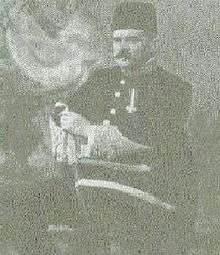Antonio Lasciac


Antonio Lasciac (1856–1946)[1] was an Italian architect, engineer, poet and musician.[1]
Heritage
Lasciac was born to father Peter Laščak and mother Jožefa Trampuš in Friulian fourth Podturn in Gorizia 21st in September 1856. He was the first of ten children. Three of his siblings died in childhood.
Due to the Slovene character of his village of Ročinj and his Slovene ancestors Laščak's heritage is Slovene rather than Italian.
Descendants
He immigrated to Gorizia and opened a business with Mihael Trampušom, another Slovene. He fell in love with Trampušom's daughter and took over his crafts workshop after the marriage. Her official Italian name is written as Gioseffa. Her father Mihael was born in Gorizia, to farmers from surrounding Kras. Lasciac's wife Marija Alojzija Plesničar was Slovene and bore three children with unusual and fully Italian names: Plautilla Angelina Francesca, Fabbrizio Antonio Giuseppe and Romeo Italico Alessandro.
Lasciac designed buildings in Gorizia[1] and many Eastern capitals and cities, especially Egypt.[1] The Khedive Palace in Istanbul and the Tahra Palace in Cairo (1907) are among his most notable works.
References
- 1 2 3 4 "FROM GORIZIA TO THE OTTOMAN EMPIRE – ARCHITECT ANTONIO LASCIAC". Italy. Retrieved 10 March 2010.
External links
- "življenjepiskraljevegaarhitekta – tinomamic". Sites.google.com. Retrieved 2013-05-21.
- "vilarafut – tinomamic". Sites.google.com. 3 October 2006. Retrieved 2013-05-21.
Further reading
- Mohamed Fouad Awad: Italy in Alexandria: influences on the built environment. Alexandria Preservation Trust, Alexandria 2008.
External links
| Wikimedia Commons has media related to Antonio Lasciac. |
- Mercédes Volait: La communauté italienne et ses édiles (French)
- Mohamed Ali Mohamed Khalil: The Italian Architecture in Alexandria Egypt (Thesis submitted to University Kore of Enna to obtain Second level master's degree in architecture restoration A.A. 2008–2009)